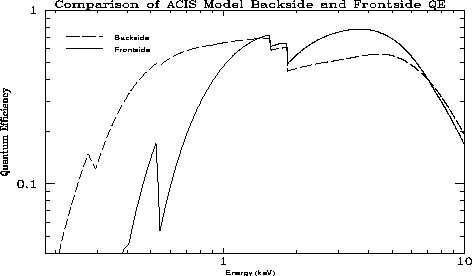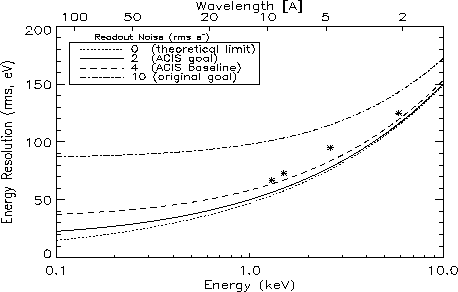
Figure 9. The quantum detection efficiency as a function of energy for front-side (solid line) and back-side (dashed line) illuminated CCDs, for events which produce a charge of more than 40 ADUs (analog to digital units) in either one or two pixels. [Figure courtesy of Andy Rasmussen, MIT]

Figure 10. The energy resolution as a function of energy for single pixel events, for four different values of the readout noise. The points show early laboratory measurements.
The QE of the ACIS CCDs is limited at low energies by the filter and the CCD design, and is limited at high energies by the finite thickness of the CCDs. Figure 9 plots the QE as a function of energy for front-side (FI) and back-side illuminated (BI) CCDs. Both CCD designs provide high QE over most of AXAF's bandpass, but the BI CCDs have a clear advantage over the FI CCDs. Unfortunately BI CCDs are more difficult to fabricate than FI CCDs with the current technology. A selection of CCD design will be made later this year.
The energy resolution of the ACIS CCDs is a function of energy and is limited by the statistical fluctuations in the number of electrons produced when an X-ray is absorbed in silicon. The energy resolution also depends on the readout noise of the CCDs, but improvements in CCD fabrication techniques have reduced this term to the point where it is a small contributor. Figure 10 plots the energy resolution as a function of energy for four different values of the readout noise. The ACIS CCDs are expected to have a readout noise of less than 2 electrons and are therefore almost at the theoretical limit of the energy resolution of CCDs.
The CCD instrument aboard the ASCA satellite has already ushered in a
new age of X-ray spectroscopy. ACIS promises several improvements
over the ASCA instrument. First, the quality of the AXAF images will
improve the sensitivity to point sources by focusing the source
photons into a much smaller region, thereby facilitating the
separation of source and background photons. Second, the effective
area of the HRMA/ACIS combination is larger than on ASCA. Third, ACIS
will have more available telemetry bandwidth, which allows the
utilization of CCD modes which preserve all the pulse-height
information, and ACIS will be able to update the bad pixel maps used to
exclude `hot pixels'. Fourth, BI CCDs would extend the bandpass
below the keV cutoff of ASCA. Finally, the readout noise of the
ACIS CCDs will be lower, thereby improving the spectral resolution.